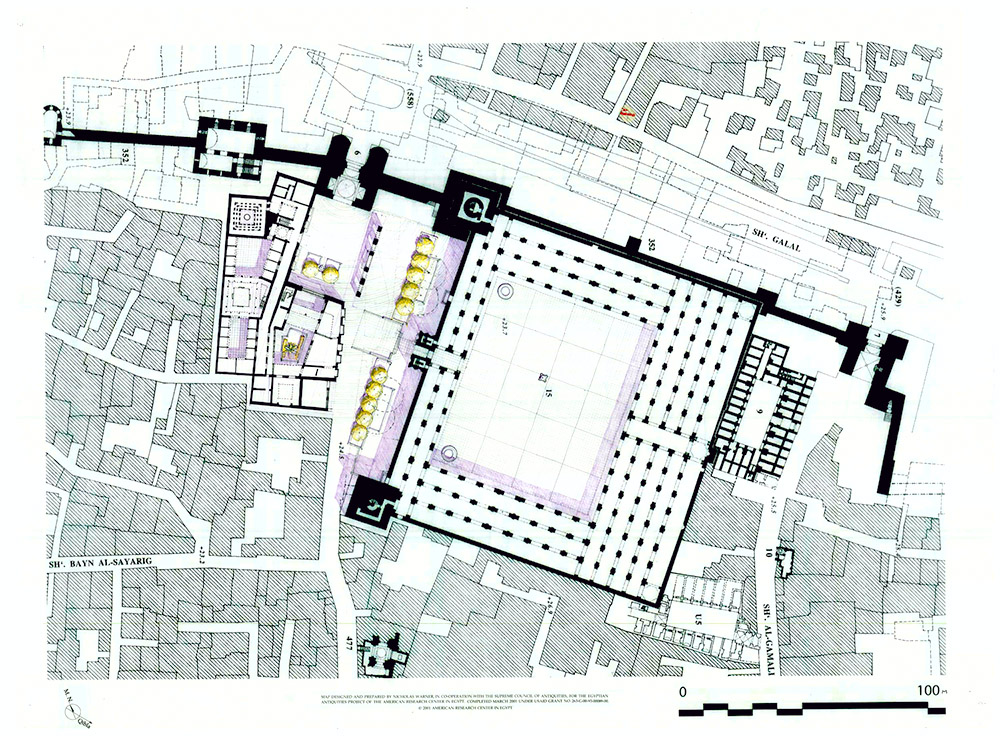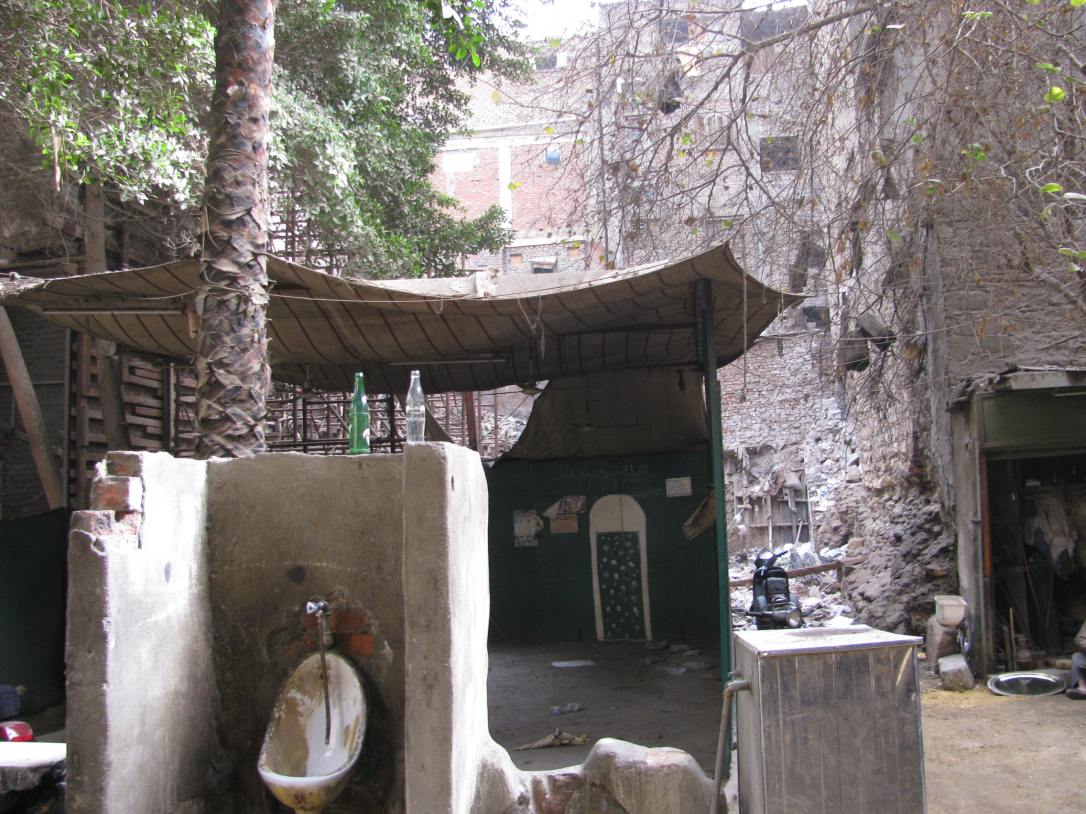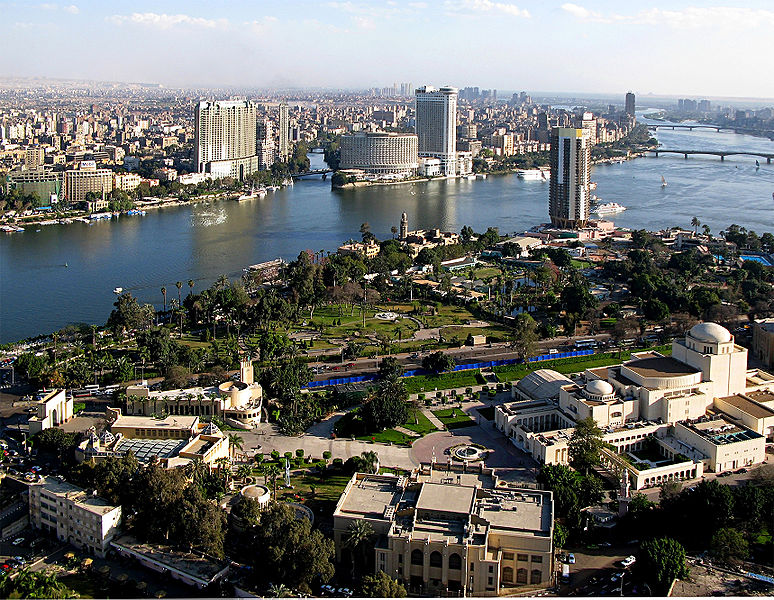“The more boundless your vision, the more real you are.”
― Deepak Chopra
On the 23rd of May, 2017, we asked our friends to tell us what their vision of the future is (link to our Facebook post here) … this article discuses ours.
Before I get into any specifics regarding our ideas, I wanted to discuss what I meant by “vision”. Many have perceived our question to be that of trying to predict the future – which can often be grim with the alarming reports of climate change. However, we have taken this opportunity to actually suggest ideas for the built environment in the future. Granted, these ideas may not be too detailed and there may be a lot of logistics that need to be figured out before implementation, but our vision for the future here is something that we hope provides food for thought for our readers, and for us as designers as well. We like to create such visions and statements in order to keep ourselves in check with every design project we do – it allows us to compare what we hope to design and what we actually design.
Back in early 2013, we entered a competition to design “a skyscraper for the future”. This competition was organized by “Evolo” magazine, and it is an ideas based competition that seeks to discuss the future of the architectural practice in terms of design rather than produce anything that is necessarily feasible in early 21st century terms. The entrants are free to bend the laws of physics and structural design as we know it to image what life could be like centuries from now (obviously trying to push for a more optimistic view of the future). Past entries have suggested flying skyscrapers, towers in space, buildings floating on the water like ships…etc. The third generation of RiadArchitecture had just started at that point, so I thought it would be a good competition to sink our teeth in and hoped to produce a controversial project to get the practice some international publicity within the design circles.
I did not want to just come up with a cool looking form and create awesome visuals, I wanted whatever we designed to stem from an important issue the world is facing today. One of the issues that Egypt faces today is that most of its urban fabric is built upon fertile soil. The country is mostly made up of desert terrain, save for a small sliver surrounding both banks of the Nile, which has become extremely fertile as it has been drinking water for thousands of years, making it ideal for farming. The City’s earliest urban fragment, El Fustat, was established by the Arabs in the 7th century, and was erected on the Eastern bank of the Nile, on fertilized soil. However, El Fustat and the subsequent neighborhoods that were established after it (until they were all grouped by Salah el Din in the 12th century to form greater Cairo) covered a small percentage of the fertile land that it seemed to be inconsequential at the time. As time progressed, the speed of urbanization and city expansion accelerated, especially in the 20th century. In the last 50 years, Cairo, and other major cities that all were established to have a connection with the Nile (their reason for being), extended along the river to connect to the neighboring cities in the other governorates, as well as exploding outwards with its suburbs. These suburbs were planned as gated pockets with the hope that would exist around fields of green, but reality allowed for the space between all these pockets to be filled with slums, which connect the city proper to its suburbs. All this urbanization occurred on fertile soil, which has been rapidly decreasing in both quality and size. Egypt, which had previously been known as a farming economy, is now looking to turn the desert terrain into fertile terrain to combat this problem, and we can debate how successful it has been in that endeavor.
But what could have been done instead? Mass urbanization to cater to our ever expanding population growth is something that we as designers and urbanists must accept as reality … but we could perhaps approach it with a better overall plan in mind and strive to build cities that retains the fertile nature of the soil. This would be the platform on which we would base the design of our utopia or vision for the future – which we aptly named “The Agronomic Metropolis”.
Throughout the history of the built environment, architects and philosophers alike have pondered on ideas of the Ideal City or Architectural Utopia. The renaissance ideal “centralized” city was planned to encompass the spiritual and juridical notion of space and social hierarchy; the church square is located in the nucleus of the urban configuration, which often replicates a geometric pattern. The nineteenth century Garden City Movement, initiated by Sir Ebenezer Howard, was planned as a reaction to the polluted industrial cities of the century before, as these cities were intended to be small-scale satellite towns that are self-contained communities surrounded by a green belt, and connected to a larger industrious parent city. LeCorbusier’s urban planning endeavors reflected a social commentary in which the architect aspired to create cities that promote equality among humanity; allowing the ground plane to be utilized by the public, while the residential units are erected in towers that act as objects in a field of greenery.
The Agronomic Metropolis borrows ideas from Le Corubiser’s theories, pushing it forward to the 21st century and contextualizing it with some of the problems the planet may face in centuries to come. The concept of The Agronomic Metropolis is to minimize construction on fertile land that could be used to farming or vegetation. On a 10,000m2 square plot of land, the building footprint would become 10%(or less) instead of the usual 50%, allowing over 90% of the plot land to be open green space that would encourage biodiversity and allow different species to be involved in this new typology of urban ecology. Parks and green spaces will cease to become objects in a field of concrete blocks anymore – where city dwellers would go to escape the city – but would be integrated seamlessly into metropolitan life, in an attempt to blur the urban and linguistic boundaries of the terms “city” and “rural”.
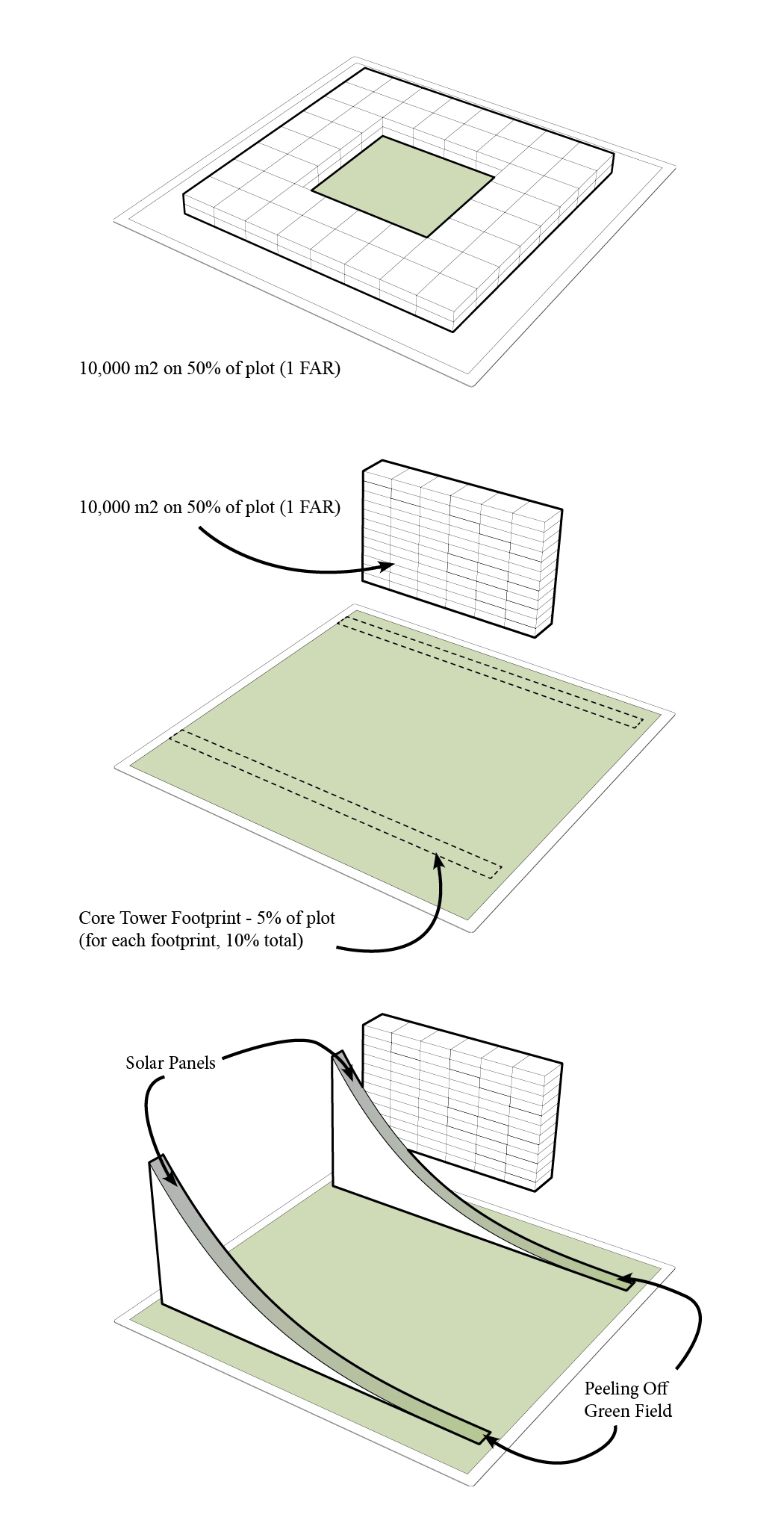

The residential and office towers are laid out so that two 6 x 100m core towers are placed on each end of the block. This core tower would house all vertical transportation, circulation, egress, structural components and public facilities. The tower stands upright on the edge of one side of the block, while curves downwards to meet the ground on the other end, allowing the core tower to appear as if it is peeling off the ground. This type of form allows one side of the tower to have an elongated façade towards the sky, creating more surface area to place solar panels. With the taller core tower in the city, the tower bows down towards the street, to allow even more exposure to the southern sun (or northern for southern hemisphere cities).
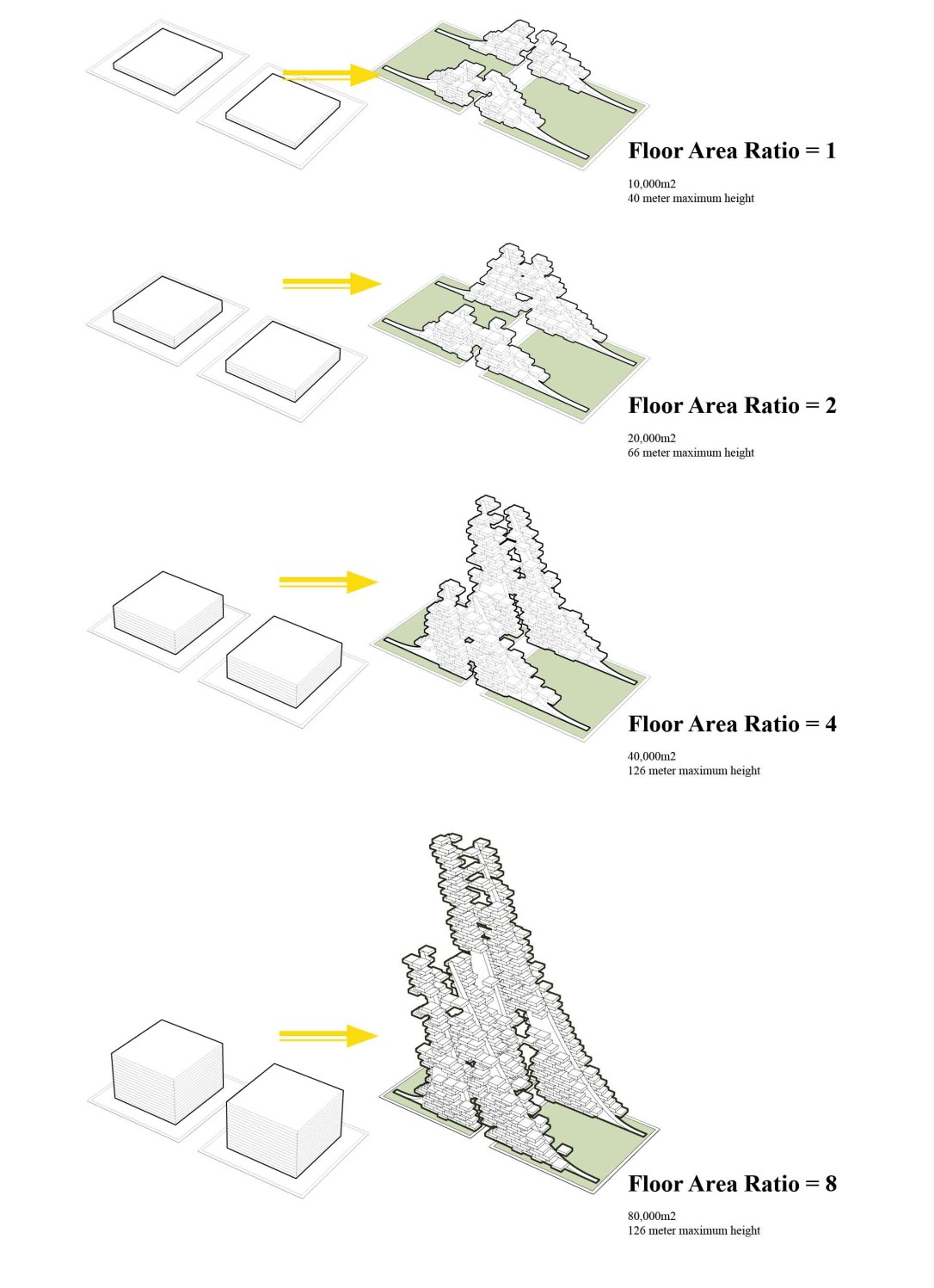
The residential and office units are laid out on a 10×10 module, and are placed on either side of the core tower. The number of the module units depends and correspond to the Floor to Area Ratio of the plot site, and each façade has a 50% porosity rate. This porosity rate allows for light and air circulation, as many of the units have exposure on two (or sometimes three) sides – while it also allows for terrace spaces for roof gardens and social spaces. The result becomes a rhythmically dynamic tower that blends into the landscape and embraces the law of randomness much akin to nature, as opposed to LeCorbusier’s pure and repetitive concrete objects that were criticized to be viewed in distortion with the natural surroundings. Take a look at the images we have posted below for what we envision our vision to be; two of the images show the towers in a low density area (hence the cows), while the other two are populated in a heavily dense area – which shows that even in areas with large population, these towers would provide for vast spaces that could foster agricultural activities.

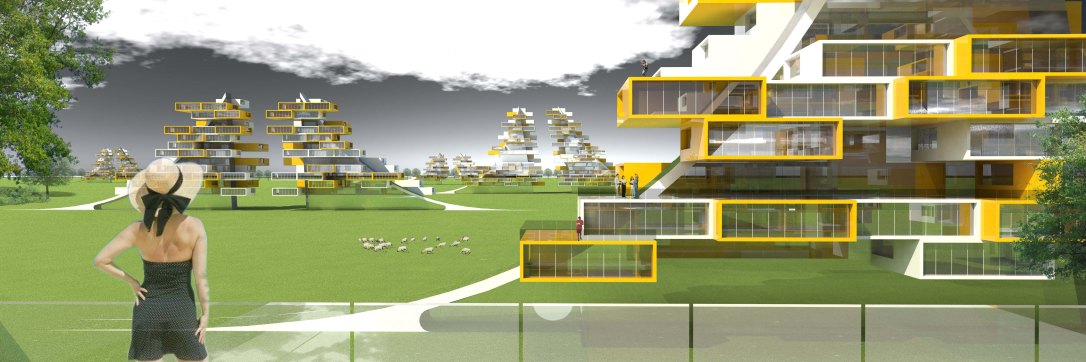


See you next week 😀
Mahmoud M M Riad
Director of RiadArchitecture





